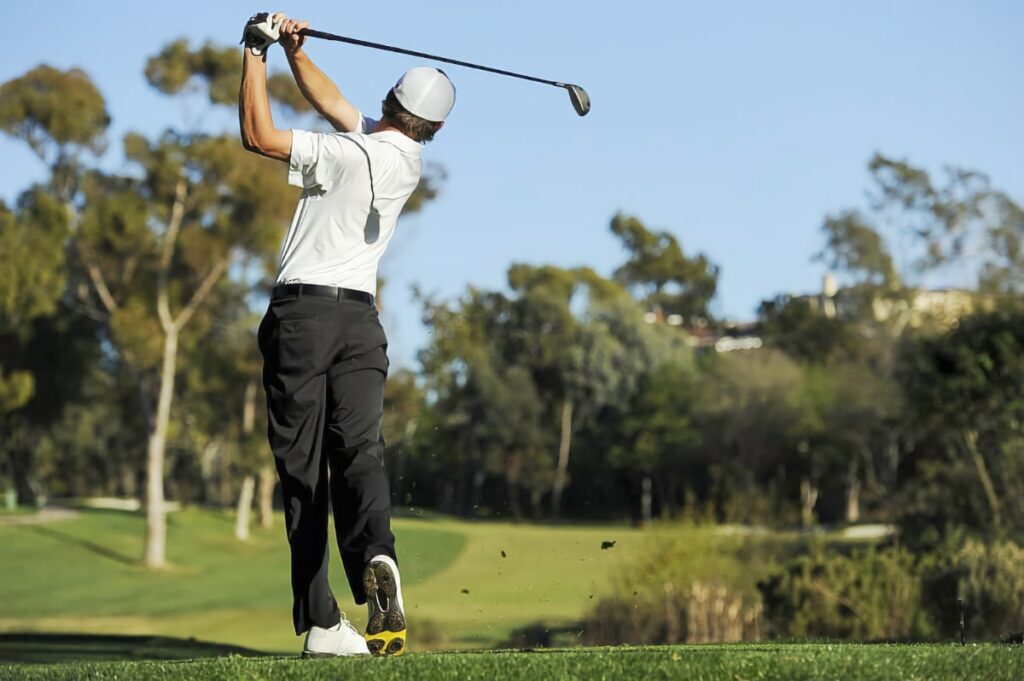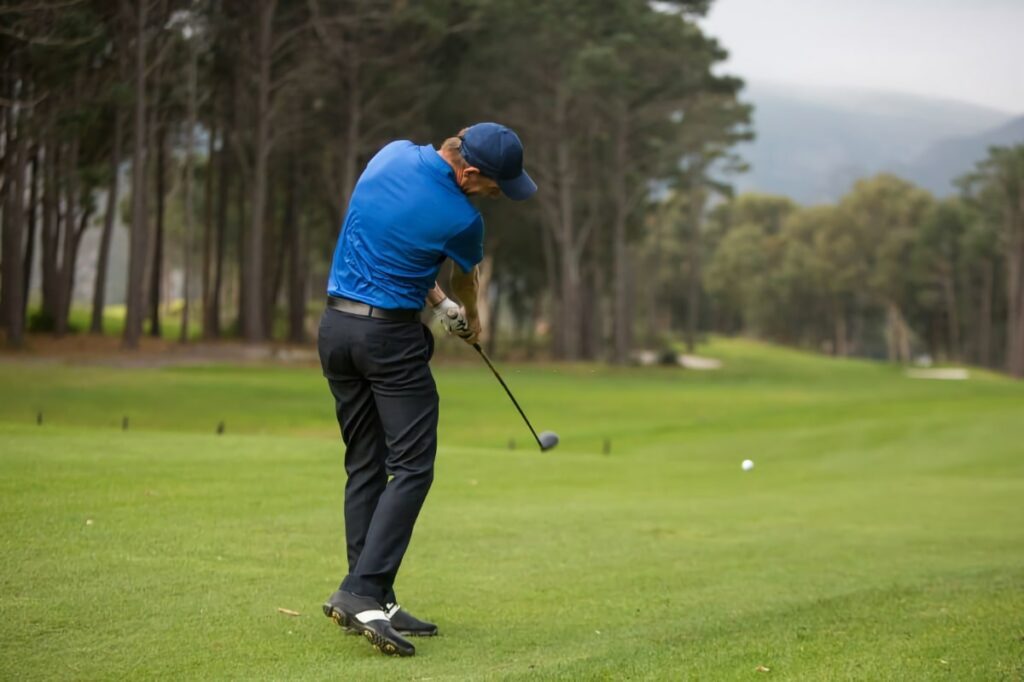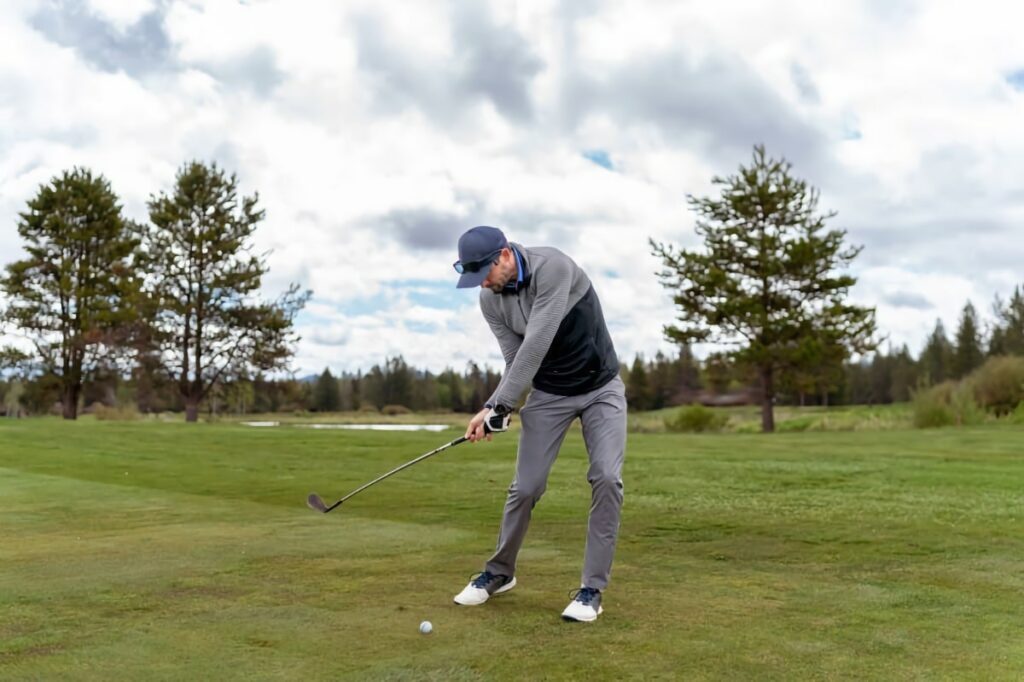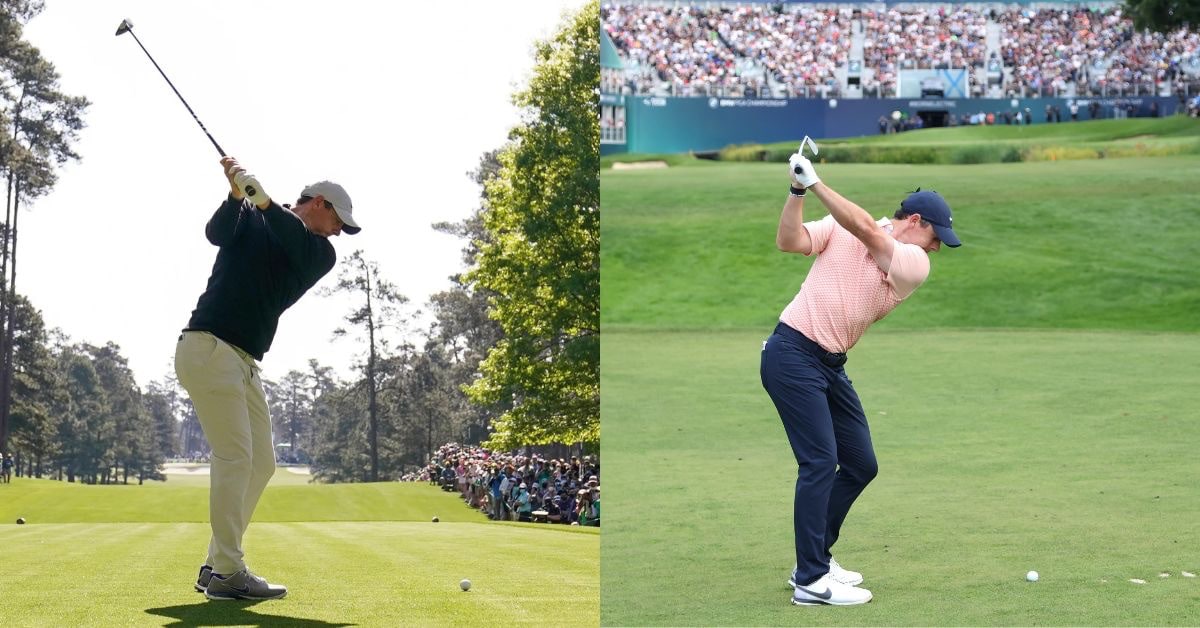The golf swing can be a challenging concept to wrap your head around.
One important thing to consider is that there should be subtle changes in the swing as you progress from the shorter to the longer clubs in the bag.
In this article, I’ll analyze the fairway wood swing vs the iron swing.
Specifically, I’ll address the fundamental elements of each swing. That way, you can ensure you’re making the right swing thoughts with each club type.
Without further ado, let’s crack on!
Fairway Wood Swing vs. Iron Swing
The key differences in the fairway wood swing vs the iron swing are ball position, weight transfer, spine tilt at setup, and positioning of the strike. If you don’t make adjustments between your fairway wood and iron swing, you won’t be maximizing your accuracy, distance, and spin rates.
First, let’s dive into the key details of the fairway wood swing.
The Fairway Wood Swing

Fairway woods can be used off the tee, or as their name suggests: off the fairway.
When hitting a fairway wood with the ball slightly teed up, it gives you the luxury to swing up into the ball for optimal launch and distance.
However, when you’re striking the ball off a fairway lie, you need to swing the club with a downward angle of attack. Otherwise, you’ll hit the ground first.
Let’s address the fundamentals of the fairway wood swing, so you start striking the ball clean and accurately directly off the turf.
Ball Position
When hitting a fairway wood directly off the fairway, the ball position should be between the inside of your lead foot and the middle of your stance.
Most fairway woods don’t have a very deep face. Therefore, you need to make sure the bottom of the club is grazing the turf just before making contact with the ball.
As a right-handed golfer, I like to find a ball position between the center of my stance and my left heel when hitting my fairway wood off the deck.
If the ball is too close to the middle of your stance, it will encourage you to strike the ball with an open clubface or pop the ball up and lose distance.
Conversely, too far forward and you’ll be prone to topping or fatting the ball.
Wide Base of Support
Next, make sure your feet are slightly wider than shoulder-width apart.
In general, your feet should be furthest apart with the driver swing, and gradually get closer together as you progress through the shorter clubs in the bag.
With the fairway wood, a wide base is important as it provides stability for the long swing while enabling you to generate power from your legs.
If you’re only shoulder width apart, you might not have the balance and stability necessary to get the speed and consistency in your fairway woods.

Spine Tilt at Setup
When you set up to hit the fairway woods, drop your trail shoulder a bit.
Remember, you aren’t necessarily trying to hit down on and compress the fairway wood like you do an iron. Instead, you’re trying to “sweep” the ball.
Therefore, this slight tilt in the spine at setup can help you return to impact in the same position, striking the ball more on the upswing for optimal launch.
Weight Transfer
As you enter the downswing, transfer your weight toward the lead foot.
Essentially, the transfer of weight from neutral → back foot → front foot will help you generate power and consistency in striking the ball first, and turf after.
If you stay more centered, you’ll struggle with inconsistencies in the strike.
So, focus on turning with your lower body and core in the backswing. Then, use that as a way to load up your weight, and shift it through the ball.
Check out a demonstration from Rick Shiels in the video below:
With the fairway wood swing, it’s vital that you control the clubface.
As Mark Immelman puts it, you want the sole of the fairway wood to “bounce off the ground as it passes through impact.”
That way, you can be sure the club is bottoming out a fraction before contact with the ball, to ensure the ball is struck out the center of the face.
To recap, here are the areas we covered:
- Ball position between lead heel and center
- Wide base of support to provide stability
- Spine tilt at setup for optimal launch
- Weight transfer through the ball
Next, let’s dive into the iron swing to see how it compares!
The Iron Swing

While the fairway wood swing is more of a sweeping action, the iron swing should be more compact and “compress” the golf ball.
PRO TIP: In golf, compression is the act of hitting down on the golf ball and “compressing” it against the turf. This is why the divot should occur after the ball has been struck.
As with the fairway wood swing, let’s cover the key details of the iron swing.
Ball Position
With your irons, the ball position should be much closer to the center.
Essentially, having the ball positioned closer to the middle of your stance will ensure that contact with the ball happens with a negative angle of attack.
Simply put, your goal is to strike down on the ball. That way, you can unlock the best strike out of your irons, improving distance and consistency.
Likewise, this motion helps generate a higher launch angle, better control of ball flight, and improved spin rates to help stop the ball on the green.
Stable Stance
Next, you want to have a stable stance with your feet shoulder-width apart.
Iron shots are not just about getting distance. More importantly, we want accuracy and consistency to be able to trust the shot with each iron in hand.
Standing with your feet shoulder-width apart will allow you to maximize rotation in your swing, encouraging an effortless swing without forced power.
Too wide, and you won’t be able to rotate efficiently around your core. Too narrow, and you’ll be prone to swaying, with very little stability in your iron swing.
Weight Transfer
As with fairway woods, weight transfer is vital in the iron swing.
Start with a little extra weight on the lead foot. This extra weight on the left will help promote a downward strike for better consistency and distance.
In the backswing, shift some of your weight to the trail foot, before unleashing your weight back onto the lead foot throughout the downswing into impact.
Personally, I like to think about this right before I swing and focus on it even more so just before I swing with a wedge. The wedge shot requires even more weight on that lead foot at impact to optimize the strike and maximize spin.
PRO TIP: The optimal weight distribution with your irons is about 60/40 favoring the lead side, to encourage a downward strike.

Minimal Spine Tilt at Setup
While the fairway wood setup benefits from spine tilt, the iron swing doesn’t.
Instead, you should aim to feel like your shoulders are more square. That way, you can encourage the motion of striking down — rather than hitting up.
Due to the trail side hand being lower on the grip, your trail shoulder will naturally be slightly lower than the lead side. However, you shouldn’t exaggerate this.
Also, it’s vital to keep your head over the ball with your irons. When you move your head too far off the ball, it’s hard to square the clubface again at impact.
Stay centered and get the concept in your head that you need to hit down and through this ball in order to get the optimal performance out of your irons.
Here’s another Rick Shiels to illustrate the perfect iron swing:
To recap, here are the key thoughts for the iron swing:
- Ball position should be close to the center
- Stable stance with your feet shoulder-width apart
- Weight transfer is important to compress the ball
- Minimal spine tilt to keep your head over the ball
PRO TIP: With irons, you’re effectively coiling and rotating around your body to generate power in the swing.
Final Thoughts
In summary, the fairway wood swing and the iron swing have subtle differences.
Simply put, the goal with the fairway wood is to sweep the ball off the turf. With irons, you should aim to hit down on the ball for optimal distance and spin.
As you get better at golf, you’ll notice that most golf lessons will deal with simple issues related to setup, stance, weight positioning, and spine tilt.
Eventually, the swing becomes very close to the same, but how we set up and prepare to hit these shots can make or break success.


